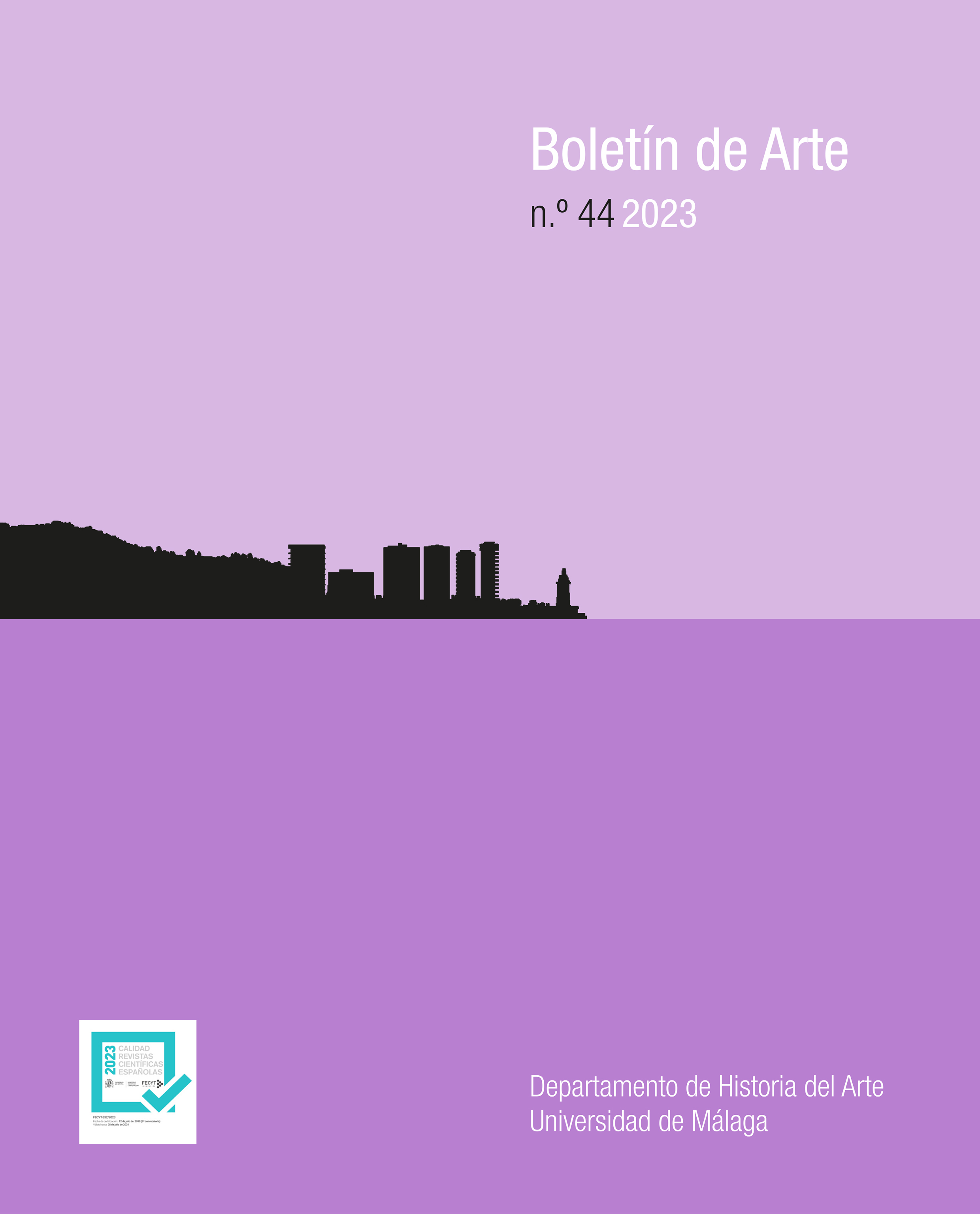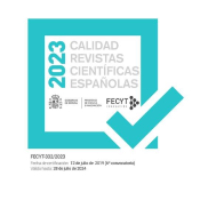5 semanas, 25 días, 175 horas (2016), de Maria Eichhorn: Subjetividad y tiempo en el trabajo posfordista
DOI:
https://doi.org/10.24310/ba.44.2023.16282Palabras clave:
Maria Eichhorn, Crítica Institucional, Subjetividad, Trabajo, Postfordismo, Arte Conceptual, PrecarizaciónResumen
En el presente ensayo, la intervención de Maria Eichhorn de 2016 en la Galería Chisenhale 5 semanas, 25 días, 175 horas sirve de base para examinar la figura del trabajador artístico en el contexto posfordista. Partiendo de un análisis histórico-artístico del gesto de Eichhorn de cerrar la galería y dar tiempo libre a su personal, exploro la nueva subjetividad del trabajador desde una perspectiva biopolítica, deteniéndome en la noción de autoprecarización. Así, un análisis de la obra de Eichhorn evidencia cómo el trabajador neoliberal se ha revelado como un sujeto que asume la responsabilidad de su inseguridad laboral y permite que el trabajo penetre en su vida privada. Sostengo que la acción de Eichhorn nos recuerda que, como efecto del desarrollo del nuevo modelo laboral, todos los aspectos de la vida están ocupados por el imperativo de la productividad, complicando las formas tradicionales de resistencia al trabajo.
Descargas
Métricas
Publicación Facts
Perfil de revisores N/D
Información adicional autores
Indexado: {$indexList}
-
Indexado en
- Sociedad Académica/Grupo
- N/D
- Editora:
- Universidad de Málaga.
Citas
ALBERRO, Alexander (2006), Art after conceptual art, The MIT Press, Cambridge, Massachusetts.
ALBERRO, Alexander, & STIMSON, Blake (eds.) (2011), Institutional critique: An anthology of artists’ writings. MIT Press, Cambridge, Massachusetts.
ALTER, Nora M., & ALBERRO, Alexander (2017), «Displacement and Redirection in the Work of Maria Eichhorn», Maria Eichhorn: Kunsthaus Bregenz, pp. 93-106.
ARANDA, Julieta, KUAN WOOD, Brian & VIDOLKE, Anton (eds.) (2011), Are You Working too Much? Post-Fordism, Precarity, and the Labor of Art, Steinberg Press, Berlin.
BOLOGNA, Sergio (1997), «Dieci tesi per la definizione di uno statuto del lavoro autonomo», in BOLOGNA, Sergio y FUMAGALLI, Andrea (eds.), Il lavoro autonomo di seconda generaziones. Secenari del postfordismo in Italia, Feltrinelli, Milano, pp. 13-42.
BUCHMANN, Sabeth (2006), «Under the sign of Labor», in ALBERRO, Alexander, Art after conceptual art, The MIT Press, Cambridge, Massachusstes, pp. 179-182.
BUTLER, Judith (2015), «Foreword» in LOREY, Isabell, State of insecurity: Government of the precarious, Verso, New York.
CARNEVALE, Graciela (2011), «Project for the Experimental Art Series 1968» in ALBERRO, Alexander & STIMSON, Blake (eds.), Institutional critique: An anthology of artists’ writings, MIT Press, Cambridge, Massachusetts.
CHISENHALE GALLERY (2016), Maria Eichhorn: 5 Weeks, 25 Days, 175 Hours [Press Release].
COPELAND, Mathieu & LOVAY, Balthazar G. (eds.) (2017), The anti-museum: An anthology. Fri Art, Koenig Books.
DELCORDE, Anahita (2021), «Let me Sleep. Dreaming about Maria Eichhorn’s 5 weeks, 25 days, 175 hours», Afterall.
DEUTSCHE, Rosalyn (1992), «Art and public space: Questions of democracy», Social Text, 33, pp. 34-53.
EICHHORN, Maria (2011), «Maria Eichhorn Public Limited Company (2002)», in ALBERRO, Alexander, Institutional Critique. An Anthology of Artists’ Writings, The MIT Press, Cambridge, Massachusetts, pp. 386-393.
EICHHORN, Maria (2016), Maria Eichhorn: 5 Weeks, 25 Days, 175 Hours, Chisenhale Gallery.
EICHHORN, Maria (2017), «Statement, 2016» in SIGLER, Friederike, Work, Whitechapel Gallery: The MIT Press, London, pp. 224-225.
FEDERICI, Silvia (2012), Revolution at point zero: Housework, reproduction, and feminist struggle, Autonomedia, New York.
FERRELL, Elizabeth A. (2006), «The lack of interest in Maria Eichhorn’s work» in ALBERRO, Alexander, Art after conceptual art. The MIT Press, Cambridge, Massachusetts.
FOUCAULT, Michel (1999), Michel Foucault: Estética, ética y hermenéutica, Paidós, Barcelona.
FOUCAULT, Michel (2008), The birth of biopolitics: Lectures at the Collège de France, 1978-79. Palgrave Macmillan, London.
GILL, Rosalind & PRATT, Andy (2008), «In the Social Factory?: Immaterial Labour, Precariousness and Cultural Work», Theory, Culture & Society, vol. 25, no 7-8, pp. 1-30. https://doi.org/10.1177/0263276408097794.
HARDT, Michael & NEGRI, Antonio (1994), Labor of Dionysus: A critique of the state-form, University of Minnesota Press.
HOLMES, Brian (2001), The Flexible Personality, <http://translate.eipcp.net/transversal/1106/holmes/en.html>.
LAZZARATO, Maurizio (1996), «Immaterial Labor», in VIRNO, Paolo & HARDT, Michael (eds.), Radical thought in Italy: A potential politics: vol. v. 7, University of Minnesota Press.
LAZZARATO, Maurizio (2006), «Trabajo autónomo, producción por medio del leguaje y general intellect», Brumaria. Arte Máquinas Trabajo Immaterial, 7, pp. 35-45.
LÓPEZ-ÁLVAREZ, Pablo (2016), «La plasticidad forzada. Cuerpo y trabajo», Daimon Revista Internacional de Filosofía, pp. 679-688.
LOREY, Isabell (2015), State of insecurity: Government of the precarious, Verso, New York.
LOREY, Isabell (2016), «Precarisation, Indebtedness, Giving Time. Interlacing Lines across Maria Eichorn’s 5 weeks, 25 days, 175 hours», in Maria Eichhorn: 5 Weeks, 25 Days, 175 Hours, Chisenhale Gallery.
MITROPOULOS, Angela (2012), «Precari-Us?», LIBRARYSTACK. Retrieved November 16, 2022, from <https://www.librarystack.org/precariat/>.
RAUNIG, Gerald (2007), «The Monster Precariat», Translate, Retrieved December 2022, from <http://translate.eipcp.net/strands/02/raunig-strands02en.html>.
SIGLER, Friederike (ed.) (2017), Work, Whitechapel Gallery, The MIT Press.
TERRANOVA, T. (2004), Network culture: Politics for the information age, Pluto Press.
VIRNO, P. (2003), A grammar of the multitude: For an analysis of contemporary forms of life. Semiotext (e).
WUGGENIG, Ulf, RAUNIG, Gerald & RAY, Gene (eds.) (2011), Critique of Creativity: Precarity, Subjectivity and Resistance in the ‘Creative Industries’, Mayfly, London.
Publicado
Cómo citar
Número
Sección
Licencia
Derechos de autor 2023 Clara Derrac Soria

Esta obra está bajo una licencia internacional Creative Commons Atribución-NoComercial-CompartirIgual 4.0.
Todos los contenidos publicados en la revista Boletín de Arte están sujetos a la licencia Creative Commons Reconocimento-NoComercia-Compartirigual 4.0 cuyo texto completo puede consultar en <http://creativecommons.org/licenses/by-nc-sa/4.0>

Los/as autores/as cuyas contribuciones sean aceptadas para su publicación en esta revista conservarán el derecho no exclusivo de utilizar sus contribuciones con fines académicos, de investigación y educativos, incluyendo el auto-archivo o depósito en repositorios de acceso abierto de cualquier tipo.
La edición electrónica de esta revista esta editada por la Editorial de la Universidad de Málaga (UmaEditorial), siendo necesario citar la procedencia en cualquier reproducción parcial o total.












4.png)
